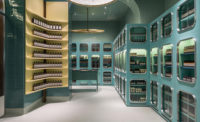Antonio Citterio and partner Patricia Viel found themselves in an enviable position. Not long after completing the Bulgari Hotel in Milan in 2004, they were approached to design luxurious accommodations for another high-end chain just a few blocks away. If the first reflected the Milan-based architects’ signature elegance and refined palette, the next—a new outpost for the Mandarin Oriental—would show off a more playful, and nostalgic, side.
Additional Content:
Jump to credits & specifications
“There’s a lot of surface decoration at this hotel, which is very unusual for us,” says Viel. “But as a brand, Mandarin Oriental wants to offer a rich experience based on the local culture rather than have a consistent or recognizable look.”
As a point of reference, Milan, of course, is a designer’s dream. Citterio and Viel drew inspiration from giants of 20th-century Italian design, including Gio Ponti and Piero Portaluppi, for the colorful and often exuberant interiors. And, in addition to outfitting the hotel with Citterio’s own furniture, lighting, and fixtures—for which he is well known—the architects chose distinct pieces by other masters, including Franco Albini, Luigi Caccia Dominioni, and Angelo Mangiarotti.
Like the Bulgari, the Mandarin Oriental is tucked into a quiet side street in the center of Milan, within steps of the city’s famous Duomo cathedral and La Scala opera house. The new hotel comprises four 18th-century residential buildings that had been converted to bank headquarters several decades ago. The merging of those classical structures, wrapping around several interior courtyards with arched colonnades, created irregular floor plates and floor slabs at varying elevations that needed to be maintained. As a result, each of the guest rooms is unique, and long corridors are occasionally interrupted by steps. Because nothing could be altered on the landmark buildings’ facades, the design team had to lay out the 72 individual rooms and 32 suites with respect to the fenestration. “Sometimes the proportions of a bathroom or the sequence of spaces are not as you would normally design them because we had to conform to existing window openings,” Viel admits.
Perhaps more significantly, as buildings that once housed the city’s upper-class families, the ceiling heights of the top floor, originally the servants’ quarters, are meager compared with those of the floors beneath, forcing the architects to locate the more lavish suites on the lower levels.
The eclectic Milano suite, on the second floor, is a tribute to Milanese designer Piero Fornasetti. His iconic pieces turn those guest quarters into a whimsical escape. An homage to Gio Ponti in another suite—with rich woods and upholstery—offers a more sedate ambience. “Designing those spaces was real fun,” recalls Viel. “The Gio Ponti suite in particular is very close to us. Ponti has always guided our interior and product design.”
Many of the remaining guest rooms feature a more neutral palette of beige and soft purples, with bathrooms covered in white or black Italian marble.
Presenting an abundance of diverse environments was at the core of the Mandarin Oriental’s strategy for this location, and it is most apparent in the hotel’s public spaces, beginning with the colorful concierge area that greets guests upon entering.
Past the lobby, where seating is laid out around a central fire pit, the bar and restaurant—both overflowing into stately courtyards—make up the heart of the hotel. The harlequinesque decor of the bar, with its wide U-shaped counter and adjacent bistro seating, is a lively counterpoint to the quieter restaurant (where meals are served on Fornasetti plates). Small pieces of black and white marble, in a modified diamond pattern, cover the walls of the bar, while a similar design is reflected at a larger scale on the floor.
The restaurant, Seta (it already has a Michelin star) features wood floors and ceilings. Accommodating up to 50 diners, it is accessible from the bar but also has a separate entrance on a main street behind the hotel, becoming a destination not just for hotel guests but Milanese as well. “It is one of the best restaurants in town,” Viel points out.
Carved out under the existing buildings, in a newly excavated basement, a 9,700-square-foot spa is a serene sphere. The dark public areas are punctuated by walls of mirror-polished, hammered stainless-steel sheets.
For Citterio and Viel—whose architectural practice has grown tremendously in recent years, with a number of large-scale, ground-up construction projects around the world, especially in Asia—the Mandarin Oriental Milan represents a more personal experience. “It’s very important for us to be involved in projects in Milan that touch this level of quality,” says Viel. “We try as much as we can to work in our city.”
PeopleArchitect: Antonio Citterio Patricia Viel Interiors — Antonio Citterio and Patricia Viel, partners in charge; Ella Dinoi, project director
Isometrix (lighting)
Mandarin Oriental
130,000 square feet
withheld
July 2015
|
ProductsDoors Lualdi, Garofoli, Rimadesio
Assa Abloy
Poliform
Pozzi-Ginori, Hansgrohe, Kaldewei, Boffi
Flos, Santa & Cole, Produzione Privata, Moooi, Lasvit, Davide Groppi, Azucena, Maxalto
Tai Ping
B&B Italia, Living Divani, Cassina, Flexform, Gervasoni |
























Post a comment to this article
Report Abusive Comment